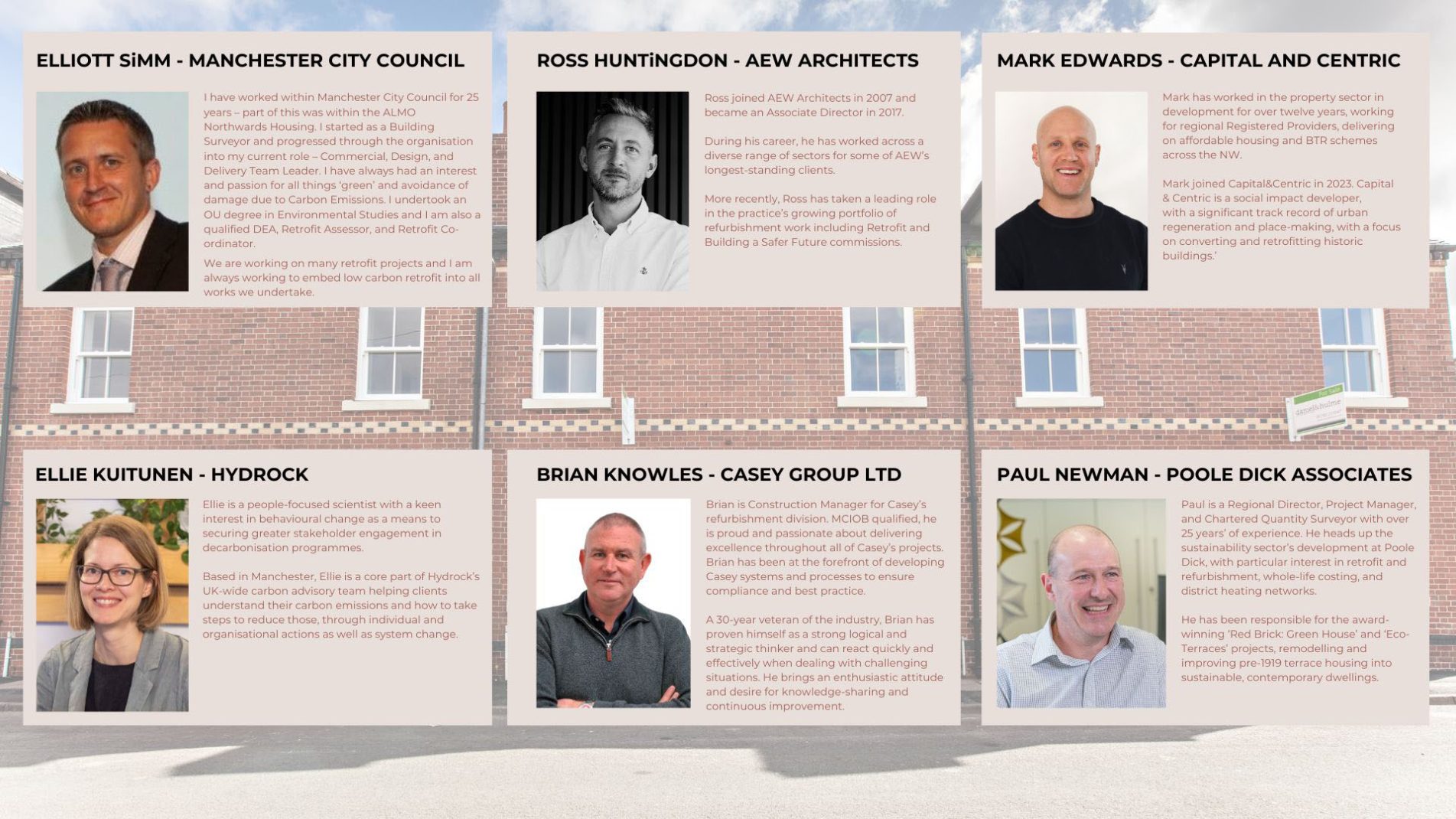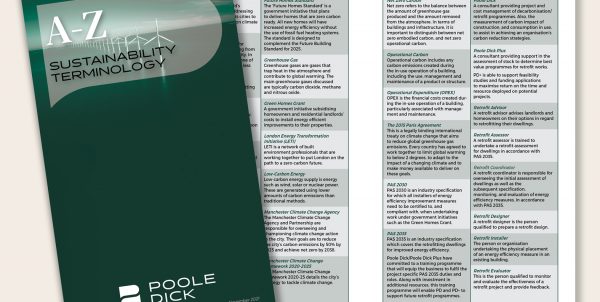Leading the charge in Retrofit Excellence: 10 Steps to Mastering Retrofit for a Net Zero World
After our insightful third ‘Preparing for a Net Zero Future’ breakfast session at the Greater Manchester Chamber of Commerce, we explored the optimal strategies for successful Retrofitting. Our knowledgeable panel and engaged audience distilled this into ten easy steps!
- Holistic Approach– Don’t think of sustainable retrofit in isolation, consider combining it with wider asset management and renewal for better economies of scale, better results, and less resident disruption
- Collaboration – More structured and effective collaboration. Don’t spend effort trying to answer the same question with endless pilot schemes, divide up the problem, focus, and collaborate
- Early Engagement –Early customer engagement, takes them on the journey for effective buy-in. Early consultant engagement to base strategy and bids on best professional advice
- Data is king, know your stock –Don’t presume. Invest in bespoke property surveys rather than generic desktop modelling.
- Political & Financial Consistency –Depoliticising away from election cycles/soundbites will provide long-term leadership and consistent messaging to give confidence in investment, training, and project planning
- Drill down on risk –Identify and allocate risks on the best information available to those best to deal with them
- Supply chain and training –Exacting standards require more training for tradespeople and management. As ever, we need to make the construction industry image more attractive to young people.
- Private sector –The ‘elephant in the room’ when focusing on public sector housing. Can the public sector direct and incentivise the private sector to invest in decarbonisation?
- Better Education & Comms –For the Construction sector and the Public as a whole. Demystify, simplify and clarify the ‘Why, what, when, and how’, helping customers know how to use their home to live comfortably with maximum benefits
- Best practices – Embrace Technology & best practice, don’t just tick the box, maintain high professional and workmanship standards
Event Panelists
Stewart Grant – Event Host, Poole Dick Associates
Elliott Simm – Manchester City Council
Ross Huntingdon – AEW Architects
Mark Edwards – Capital and Centric
Ellie Kuitunen – Hydrock
Brian Knowles – Casey Group Ltd
Paul Newman – Poole Dick Associates
Event Q&A Sessions
Panelist Questions and Discussions
What’s the best advice you’d give anyone (client, landlord, design consultant, occupier etc..) just starting/setting out on their retrofit journey?
Paul: Don’t delay, there’s a lot to do, there’s always time pressure so get on with the process.
Paul: Get into the details. Data is king and you must know your stock.
Elliot: More collaboration and early-stage involvement.
What’s the key lessons you’ve learnt about Retrofit in the last year or so or since you’ve been involved?
Ellie: Ellie noticed just how hard and time consuming it is to get these programmes going. RPs can’t look at retrofit works in isolation, more holistic approach for multiple benefits.
Mark: Early engagement with design team and contractors as soon as possible. Lots of difficulties to be overcome and early engagement can pay dividends.
In terms of skills and the supply chain, CLC/IPPR suggest we need 1.2m direct jobs and 1.5m indirect jobs to deal with the Retrofit pipeline ahead. A third of all UK construction output is currently in the ‘Repair, Maintenance and Improvement’ category. Yet there’s only a handful of major contractors actively involved in Retrofit. Why is that and how are we going to manage the upskilling required – and fast?
(Construction Leadership Council, Institute for Public Policy Research)
Brian: The contractors already delivering must take ownership of the parts that are in their control. Contractors face certain barriers like having to go down the PAS route and the uncertainty surrounding funding. Funding needs to be a long-term plan that isn’t so subject to change.
Elliot: More engagement with schools and colleges.
Mark: The perennial problem with construction is that there are just not enough people to deliver to the targets set up. Not enough is being done, despite a general willingness for it to change. The government has changed its mind too often on what/how to implement various ideas.
Stewart: Needs to be depoliticised. Perhaps a body similar to the Infrastructure Commission.
Mark: Young people should be aware that you can go into the construction industry and make a lot of money.
We’re focussing on Retrofit and decarbonisation of existing stock. But of course, we continue to build new stock. How can we future-proof what we’re building now (whether new build or new interventions into existing) so that these buildings don’t need to be retrofitted in the future and increase the burden?
Ross: Need to demystify EPCs and do full energy performance analysis (see presentation notes above). E.g. Thinking longer term for enhanced specification.
Mark: Viability issues with futureproofing. Is the consumer willing to pay a high premium for a product that’s more energy efficient? Until that is the case, not everybody will move in the same direction.
As with all construction projects, the key is in achieving the optimum balance of Quality, Time, Cost, and Risk. Paul, when you speak to clients about their Retrofit programme, do you see any consistency in their priorities and how are you advising them?
Paul: “Time, cost, quality… Pick two.” You have to be realistic and understand the true priority of the client. Risk is inherent to retrofit. It’s about understanding those risks and allocating them appropriately. Not always a case of transferring to others as this can be costly.
Mark: Do you do pilot properties?
Paul: Use pilot properties or void properties to get into the buildings and find the risks early on. We try to do a lot from a desk, but we need to get out into the properties and see exactly what we’re dealing with.
Elliot: We need that risk allowed for in the budgets.
Beyond mainstream housing, how are you dealing with the conversion and repurposing of the sort of complex, often neglected historical buildings you’re involved with at Capital & Centric. Buildings that may have stood vacant for donkeys such as Crusader Mill or Littlewoods. How do you go about recovering and futureproofing them back into commercial/mixed-use standards?
Mark: Lots of declining town centres with void properties that could be repurposed. There needs to be an acceptance that they can’t be the same standards as other buildings or new builds. Creating a great space to be and one that’s environmentally friendly can be difficult to do.
Ellie: Good to hear embodied and operational carbon both within the conversation. Ellie has authored research and written articles on how we can scale up retrofit through better engagement, infrastructure, and governance. Can you give us a snapshot of the key issues and recommendations?
Ellie: Today we have spoken about individual properties and groups of properties. Ellie has been thinking about achieving retrofit at scale. Technology is not the issue as we have the systems to do the work or at least research can be done to develop the technologies that we do have.
There are so many actors involved. Consultants, contractors, builders merchants, product manufacturers, homeowners, etc… All of those actors need to have the capability, opportunity, and motivation to act in a certain way to get to the point of retrofitting properties at the scale required. Need to approach it like any other large infrastructure project.
The occupier is key in this process. How can we put them front and centre to get the best results from the construction process and monitoring post-completion? Are there any lessons learned in the private sector of benefit to the public sector housing challenge?
Mark: Great success with engaging residents throughout the entire process. Take them on a journey. Residents need a good reason to allow for the disruption that retrofit works cause.
Brian: Engagement often doesn’t happen until funding is secured and everything becomes a rush. It may be better to engage with customers earlier.
Retrofit is an extremely complex, technical subject. So inevitably, the language of Retrofit has become extremely techy, and full of jargon. Do we need stronger National guidelines/governance to help join everything up?
Ross: There are lessons learned from the Building Safety Act. Dame Judith Hackitt has basically, said stop waiting to be told, you’re all professionals, do it right then you tell us why you’ve done it that way. We should just be doing things because we have the knowledge and it’s the right thing to do.
Stewart: But there are obstacles in the way of a more streamlined process.
Paul: Retrofit is complex and technical but it’s not rocket science. It’s simple principles. Perhaps need a national guide to give a clear and consistent message and to keep a bigger picture in our minds.
Paul: PAS2035 has its own set of jargon, but we can’t let it become diluted into a ‘box-ticking’ exercise. Need to maintain a high level of professional standards (consultants, designers, contractors, managers etc…). Clients appear to think that PAS2035 is the best practice. Keep the consultants front and centre.
Audience Q&A Session
Thermographic imaging experience?
Elliot: Useful tool but must be very careful how to interpret the image and rely on the data.
Lots of admin associated with PAS2035?
Elliot: A bit of pain now, saves a lot of pain later.
More sophisticated conversation than other events – well done. What about the private sector?
Mark: It is a big elephant in the room. The government needs to engage with the private sector nationally to address this, though that does cost lots of money.
So what’s the answer?
Stewart: A nationally mandated definition of retrofit would help.
Elliot: There’s a lot already there in terms of guidance, funding, supply chain, and professional knowledge, and now also with the PAS2035 process. Use trigger points of a medium-term plan from now until 2050 and don’t try to do everything at once.
Ross: Designers need to present it in a palatable way to clients and homeowners. Not just data.
Is there a way to bring retrofit works together with new build and re-gen schemes?
Mark: More debates and discussions within the sector and less working in isolation. More working together more consistently.
Ellie: We shouldn’t all be spending effort trying to answer the same question. We should divide the questions up and collaborate better.
On a retrofit scheme that Poole Dick (PN) was involved with, it was part of a wider master plan. The same area ended up with new sports facilities and all sorts. It captured people’s imaginations and they bought into the wider vision.
Paul: It transformed the area and the properties into somewhere that people were proud to live.
If you had a magic wand, what are the key thing/s you’d do/change to make Retrofit a more joined up/effective process?
Ellie: Take a more holistic approach and think about retrofit in the context of everything else needing to be addressed.
Mark: Take this whole topic out of the political sphere. Something that will stretch across consecutive governments and build momentum and consistency.
Elliot: Change to the press. If you get something wrong in the area of retrofit then you can get bad press that puts people off the idea of retrofit. Perhaps more case studies and education.
Brian: Same as Mark. Needs collaboration, consistency, early involvement, and a lifespan.
Paul: An effective way to educate everybody so that all of the different people involved understand the why. And a basic understanding of how to live in a house comfortably.
Ross: We are trying to improve homes and lives. More accessible government funding. Can businesses be leading the way on certain elements of delivering the retrofit targets.
To discuss any of the themes and topics raised in this article, don’t hesitate to contact Paul Newman or any member of the Poole Dick team





